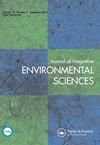Evaluation of the potential environmental impacts of condom production in Thailand
IF 3.5
4区 环境科学与生态学
Q3 ENVIRONMENTAL SCIENCES
Journal of Integrative Environmental Sciences
Pub Date : 2021-01-01
DOI:10.1080/1943815X.2021.1949354
引用次数: 1
Abstract
ABSTRACT This study aims to analyse the potential environmental impact of natural rubber (NR) condoms over its entire life cycle. The environmental performance of the production process of NR condoms is also compared to that of synthetic polyisoprene (PI) condoms. Options to reduce the environmental impact of condom production are proposed and evaluated. The potential environmental impacts are quantified by life cycle assessment (LCA). The study takes a cradle-to-grave approach, and considers six phases: 1) fresh latex production, 2) concentrated latex production, 3) condom production, 4) condom use, 5) condom transportation, and 6) condom disposal. The comparative analysis of NR and PI condom production takes a gate-to-gate scope. The functional unit is one gross condom. The results indicate that the condom production phase has the largest share (34–73%) in the environmental impact during the life cycle of NR condoms, followed by the disposal phase (20–60%). Comparing the production of NR and PI condoms reveals that the production of PI condoms results in a 1.5–2.5 times higher environmental impacts than the NR condom production, due to higher electricity consumption, especially for the compounding, dipping, and leaching processes. Reduction of electricity use is a key measure to reduce the environmental impact. Combining natural gas with electricity for the dipping process is a promising option to reduce the electricity use; it results in ~10–17% reduction in environmental impacts.评估泰国生产避孕套对环境的潜在影响
摘要本研究旨在分析天然橡胶(NR)避孕套在其整个生命周期内对环境的潜在影响。并将天然橡胶安全套生产过程的环保性能与合成聚异戊二烯(PI)安全套进行了比较。提出并评估了减少避孕套生产对环境影响的各种办法。通过生命周期评价(LCA)对潜在环境影响进行量化。该研究采用了从摇篮到坟墓的方法,并考虑了六个阶段:1)新鲜乳胶生产,2)浓缩乳胶生产,3)安全套生产,4)安全套使用,5)安全套运输,6)安全套处置。NR和PI避孕套生产的对比分析采用门到门的范围。功能单位是一个毛避孕套。结果表明:天然橡胶避孕套生产阶段对环境的影响最大(34-73%),其次是废弃阶段(20-60%)。通过对比NR避孕套和PI避孕套的生产,可以发现PI避孕套的生产对环境的影响是NR避孕套生产的1.5-2.5倍,主要是由于复合、浸出和浸出过程的耗电量更高。减少用电是减少对环境影响的关键措施。将天然气和电力结合起来进行浸出过程是一种很有前途的选择,可以减少用电量;对环境的影响可减少10-17%。
本文章由计算机程序翻译,如有差异,请以英文原文为准。
求助全文
约1分钟内获得全文
求助全文
来源期刊

Journal of Integrative Environmental Sciences
ENVIRONMENTAL SCIENCES-
CiteScore
3.90
自引率
0.00%
发文量
13
审稿时长
>12 weeks
期刊介绍:
Journal of Integrative Environmental Sciences (JIES) provides a stimulating, informative and critical forum for intellectual debate on significant environmental issues. It brings together perspectives from a wide range of disciplines and methodologies in both the social and natural sciences in an effort to develop integrative knowledge about the processes responsible for environmental change. The Journal is especially concerned with the relationships between science, society and policy and one of its key aims is to advance understanding of the theory and practice of sustainable development.
 求助内容:
求助内容: 应助结果提醒方式:
应助结果提醒方式:


